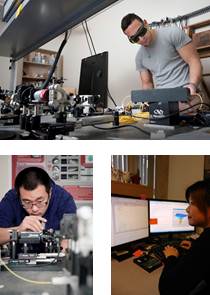Summer 2017 USRA Opportunities with the BORG
1) Real-time Tracking System
2) Adaptive Optics System Design
3) Biomedical Laser Imaging Systems
4) Virtual Reality / Augmented Reality 3D Visualization
Background: Medical imaging provides
the ability to look inside biological samples non-invasively. Techniques like
CT, MRI, and ultrasound are designed for whole body imaging, and microscopes
are used for looking at cells. There is a missing layer between them for studying
small biological systems which are on the order of millimeters. A newly
emerging technique for imaging is called Optical Coherence Tomography (OCT)
which is similar in principle to ultrasound, but uses light instead of sound
waves. OCT systems have resolution and imaging depth intermediate between
microscopy and high frequency ultrasound, filling an important technological
gap. OCT is widely used to image eyes (ophthalmology), diagnose cancer, and
also as a tool to augment studies in developmental biology.
Skills: high-level language programming skills (eg C, C++, C#) are a must. Experience with GPU programming would be an asset.
1) Real-time Tracking System
Objectives: This research project will have a student investigate Graphics Processing Unit (GPU) acceleration of image tracking. The initial modules the student will be designing will focus on furthering the existing work on real-time image segementation of 3D image data and feature tracking. This project will strengthen the student's software design skills in real time applications using graphics cards. Minimum experience is ENSC 251, and completion of advanced programming courses would be an asset.Skills: high-level language programming skills (eg C, C++, C#) are a must. Experience with GPU programming would be an asset.
2) Adaptive Optics System Design
Objectives: The purpose of this project is to learn about high resolution imaging using adaptive optics (AO). The same AO technology that is used for sharpening the focus of telescopes acquiring images of the stars can also be used for high resolution microscopy. The purpose of AO is to correct aberrations in the lenses and in the sample in order to obtain diffraction limited imaging performance. The student will participate in on going development of a computational approach to aberration correction similar to autofocus on a camera, but also correcting higher order aberrations. The first portion of the coop will focus on developing and understanding of the theory, followed by an experimental concentration in one aspect as determined by the Undergraduate Research Assistant's strengths and interests.Skills: Students that have completed the undergraduate courses in MATH (ie 251, 254) and PHYS (321) are preferred.

